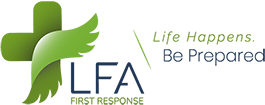Personal protective equipment or PPE is any clothing or equipment worn or used by workers to reduce health and safety risks. Common types of PPE include face masks, hard hats, safety classes, safety harnesses and respiratory protective equipment.
In the healthcare industry, PPE is particularly important for preventing the spread of infectious diseases such as COVID-19. Proper use of PPE not only offers protection to healthcare workers, but also reduces health risks for patients and the public.
In this guide, we explain when PPE should be used in the workplace, why choosing appropriate PPE is so important and what types of PPE are essential for healthcare workers.
Why is PPE important?
Personal protective equipment protects employees from health and safety risks, such as infectious diseases, hazardous chemicals and physical dangers. While PPE is not required in all circumstances, many workplaces require PPE as part of a holistic workplace safety plan.
In many healthcare settings, proper use of PPE is mandatory, offering protection to healthcare workers as well as patients and visitors. Correct use of PPE provides a safety barrier between the nose, eyes and mouth and potentially hazardous materials such as bodily fluids, blood and respiratory secretions.
Also read: Getting serious about safety procedures in the workplace.
When should PPE be used in the workplace?
PPE is not required in every circumstance. A workplace risk assessment can be used to determine when PPE should be used in the workplace, and what type of PPE is appropriate. According to Safe Work Australia, PPE should be used as a last resort if administrative controls are not enough to reduce or remove the risk. In many healthcare settings, PPE is also used as a backup for other safety measures, or as an interim measure while other safety measures are being checked.
In medical settings, PPE should be used for workers, patients and visitors when there is likely to be contact with blood, bodily fluids or hazardous chemicals. Other circumstances where PPE is recommended include:
- Healthcare workers working with patients who have COVID-19 or patients with a compromised immune system
- Paramedics and first responders
- Allied health professionals
- Aged care workers
- Disability support workers
- During cleaning and disinfecting procedures
- When handling hazardous chemicals
How effective is PPE for healthcare workers?
When used properly, PPE can be highly effective at improving workplace safety. To improve the effectiveness of PPE in healthcare settings, Safe Work Australia recommends the following control measures:
- Use appropriate PPE for the specific work being performed and the specific hazards faced.
- Ensure PPE is a suitable size and fit for the person using it.
- Where necessary, use disposable PPE that can be safely removed and disposed of immediately after use.
- PPE should be properly stored and maintained.
- Replace PPE when it has reached its expiry or usable life date, or if it is damaged or contaminated.
- Employers should provide PPE training to ensure employees know how to use PPE devices properly and effectively.
Essential PPE supplies for healthcare providers
Personal protective equipment such as eye protection, face shields, face masks and gloves are used as standard practice in many healthcare settings. These types of PPE can also be used for COVID-19 prevention in other workplaces and industries.
Gloves
Disposable gloves are used to protect the hands when handling bodily fluid or blood. Nitrile gloves are the industry standard, as they don’t contain any latex which may cause a serious allergic reaction in some patients. Gloves are particularly important for preventing cross infection in first aid and should be included in first aid kits for schools, workplaces and healthcare settings. Cut resistant gloves should be used when handling sharp implements such as scalpels, knives and needles.
Face masks
Face masks protect the mouth, nose and respiratory system from infectious materials and hazardous particles. There are many different types of face masks suitable for healthcare settings, including N95 masks, surgical masks and respirators. Disposable face masks reduce the risk of cross infection, but reusable face masks may be appropriate in some circumstances. Child sized masks should be used for children to ensure the right fit.
Also read: What does N95 mean?
Eye protection
Eye protection PPE includes items like safety glasses, goggles and face shields. These protect the mucous linings in the eyes from blood and bodily fluids. Medical face shields offer additional protection of the mouth and nose as well as the eyes. Being made from transparent materials, medical face shields allow facial expressions to be seen which can be important in some types of healthcare settings. Some types of face shields can be reused if they are cleaned and disinfected properly.
Clothing
Protective clothing such as aprons, head caps, shoe covers and polyethylene gowns are often worn during surgical procedures, but may also be required for other procedures. These items protect healthcare workers and patients from the transfer of microorganisms and bodily fluids. Protective clothing items can offer varying levels of protection and should be selected according to the specific circumstances and risk level.
Order PPE supplies at LFA First Response
If you require PPE for medical settings, first aid situations or workplaces, the team at LFA First Response can help. We supply a wide range of personal protective equipment and COVID-19 prevention supplies at excellent price points and first rate shelf life. Place an order online, or give our friendly customer service team a call on 1800 681 544.



















